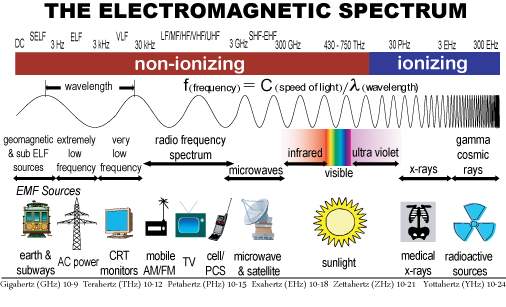
RF Safely
Devices with RF Radiation warnings on them should be treated with care and caution. These devices, typically antennas for different types of radio communication, emit radiation waves that can cause RF poisoning, or even severe burns!
Do not touch devices or wires that have RF Radiation warnings on them. If touched while transmitting, antennas can cause instantaneous and severe burns!
RF Radiation Does not Cause Cancer – Explanation of RF Radiation
While RF Radiation can be dangerous, it does not cause cancer. Radiation is a term that covers all types of radiating waves. While X-Rays are a type of radiation, visible light is also radiation.
To cause cancer, radiation has to be ionizing. Simplified, it means that the wave is high enough in frequency and power that it can remove electrons from atoms and molecules in the matter through which they pass. When this happens within human cells, it alters the cell. After enough exposure, the likeliness of one of these changes creating a cancerous cell becomes higher.
The below image displays the electromagnetic spectrum. Notice the “Radio Frequency Spectrum” is below the section of “ionizing radiation.” In fact, it is below visible light! If radio-waves caused cancer, visible light would be deadly.

So if there are no dangers of cancer, what dangers do radio frequency radiation pose? While these waves are not high enough in frequency to alter cells and cause cancer, they still have electrical power in them, which can be absorbed as heat. RF radiation is absorbed best by objects that are at a resonant wavelength to them. If an object is a similar length to a particular radio wave, it will absorb its energy more efficiently. That is why antennas need to be specific lengths for specific frequencies.
Humans are not resonant for most radio waves, so they do not absorb it efficiently (there are wavelengths that are resonant to the average human, but these frequencies are tightly controlled and typically are not used for communication). This is why distance must be kept from antennas or other devices labeled with “RF radiation.” RF Exposure can slowly build up as your internal temperature rises, leading to sudden onset of its symptoms. Luckily, unlike with ionizing radiation, exposure does not build up in the same way, so once someone cuts off exposure, they will quickly recover unless it got to a very severe point.
When touching a transmission antenna or other radiating element, one becomes part of that antenna in a way, and provides a direct path for that energy. This is the most dangerous, and can quickly result in burns at high power.
Note that antennas are only dangerous while they are being used to transmit. The antenna on a car’s FM radio for example isn’t dangerous, as it is used to receive waves only. For transmitting antennas, like those used for ham radio, the antenna is typically used for both transmission and receive. These antennas are dangerous when transmitting, and the safe distance from the antenna varies depending on the frequency and power being used.
While it is the ham operator’s duty to keep their antenna in a controlled area at a safe distance from others, it is best to not assume safety and to keep your distance and verify safety with its owner.
My Specific environment
In my case, I have two antennas at my apartment building. One VHF/UHF antenna up at my window, and one HF long-wire antenna in the woods. Both antennas are kept away from other people, and I restrict my power output to 100 watts maximum to keep my neighbors safe.
Sources
- https://www.cancer.org/healthy/cancer-causes/radiation-exposure/radiofrequency-radiation.html
- https://www.cancer.gov/publications/dictionaries/cancer-terms/def/radiofrequency-radiation
- https://www.arpansa.gov.au/understanding-radiation/what-is-radiation/ionising-radiation
- https://www.cdc.gov/nceh/radiation/ionizing_radiation.html
- https://pbs.twimg.com/media/EbbMP_zXQAASg7q.png
